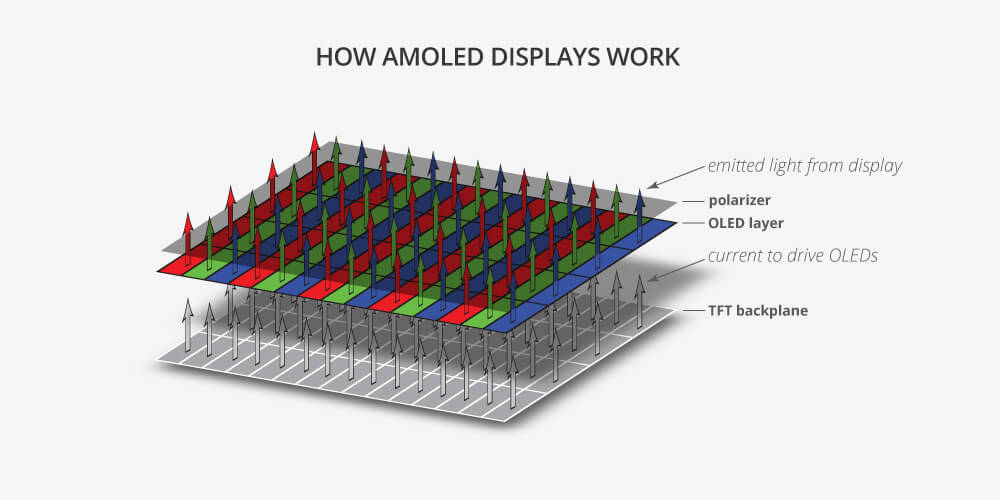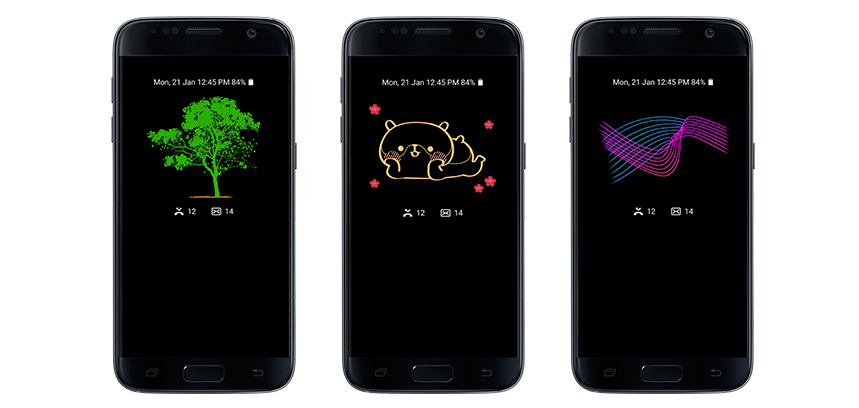Apart from processors, which we discussed in our recent article MediaTek vs Qualcomm: Which smartphone processor should you choose? another notable factor in choosing a smartphone can be the display. Because, to be honest, the display is where we see all the magic happen, so it got to be on our priority list. Most often, the Resolution numbers are directly proportionate to the quality, but, the technology used for those pixels is often where most of us get bemused. If we take smartphones, the two major technologies used are AMOLED and LCD. However, how exactly these displays differ and what should you choose?Let’s first find out how they work.
AMOLED
Let’s start with AMOLED displays. Now, a lot of you might have already guessed the technology here as AMOLED is actually a variant of the famous OLED display technology used in Televisions. To start with, LED stands for Light Emitting Diode and the O here adds up as Organic LED. Further, AM is an abbreviation for Active Matrix which actually helps to light up a particular Pixel when needed. So we now know what actually AMOLED stands for, but how does it work?

As the name suggests, OLED displays generate light from individual pixels. In other words, each LED pixel when provided the adequate current can light up for itself. Further, all AMOLED displays also contain a TFT (Thin Film Transistor) which makes the whole process of sending the current to the right pixel a lot more smoother and quicker. Further, having an Active Matrix in place, the TFT also helps to grab the right control to operate various pixels. For example, in AMOLED displays, some pixels can be completely switched off while others are on, thus, producing deep blacks.
Samsung markets this technology as Super AMOLED because the South Korean giant actually blends in the capacitive touch screen right inside the display which not only makes the display thinner but also makes it a tad bit better in terms of responsiveness.
LCD
Coming to LCDs, which is relatively more common on smartphones, stands for Liquid Crystal Display. Unlike AMOLED displays where each pixel lights up for itself, LCD displays have a dedicated backlight which is white in colour or maybe with a blue tint because white light is basically the combination of all the other colours. In most cases, we have a blue light which is then passed through a yellow phosphor filter resulting in a white light.

This white light is then passed through a couple of filters (first vertical than horizontal) after which the crystal elements are passed through Red, Blue and Green filters forming sub-pixels which further form pixels spread across the entire display. Also, LCD displays can have both active and passive matrix depending on the requirement and the cost involved.
For comparison, the process here is a lot more complicated and requires a lot more steps to complete, hence, this is why LCD displays are relatively less battery friendly when compared to the AMOLED.
However, is one technology better than the other? Although AMOLED displays apparently points out to the future, both the display technologies have their own pros and cons which, in our opinion, will be enough for you to decide as to which one is better. So how exactly do they differ?
1. Cheap vs Expensive
The first difference which I want to highlight is the cost of both the technologies. The probability of you finding an AMOLED Display on a budget smartphone is a lot less than LCD displays. This is primarily because LCD displays are cheap to manufacture and procure while AMOLED or OLED displays, in particular, involve much higher cost.
2. Colours
Well, this is probably one of the important differences. A display’s quality is generally measured by the sharpness and colours it produces. Furthermore, to rate a display better only based on its technology might not be possible because displays tend to behave differently even when the same manufacturer uses the same technology. Nevertheless, if we consider colours specifically high contrasting colours like Red, Blue and Green, AMOLED displays will serve you much better all day. This is because, in an AMOLED display, each pixel emits it own light while in an LCD, the light is sourced from a backlight. In other words, AMOLED displays put up more vibrant colours and hit high bars in saturation.
While an AMOLED display has a much larger colour gamut, LCD displays will pop cleaner whites. This is why most of the AMOLED displays are warmer in nature as they come with a yellow or red tint to the whites.
To sum up, you are more likely to get amazed by looking at a picture on an AMOLED display while LCD will put a more real ‘picture’ of a picture.
3. Brightness
The backlight on an LCD display helps it win in this department as AMOLED displays are often criticised to have low brightness levels. So if you are the one who is mostly out under the sun using your smartphone, an LCD display might be a much wiser choice. To contradict, AMOLED displays, especially Samsung’s Super AMOLED displays are slowly reaching there in terms of brightness.
4. Battery Consumption
There are tonnes of other things sucking your smartphone’s battery but the display generally top the charts, so battery consumption is important. Pixels on an AMOLED display can be completely shut off, so naturally, it saves more juice when you are operating on a black background as the pixels for that part of the displays will be switched off. LCD display, on the other hand, relies on a dedicated backlight which still remains switched on even if you are on a completely black screen. This is why features like Always On Display or Active Display on Moto smartphones make a lot more sense on an AMOLED display while it will definitely affect your battery stats on an LCD display. So think twice before using the ‘Always On’ display feature on your LCD display smartphones.

So which one is better for you?
Taking in the majority of the pros and cons for both the displays, AMOLED panels will any day outperform an LCD panel if colour and battery consumption is a concern. Further, even though AMOLED panels struggle a bit with brightness levels, it slowly catching up and in our opinion and is hardly noticeable in most cases.


